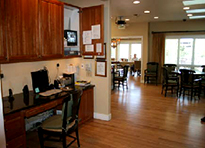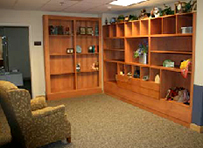A therapeutic environment is an environment that is supportive of each individual and recognizes that people with dementia are particularly vulnerable to chaotic environmental influences. It is individualized, flexible, and designed to support differing functional levels and approaches to care (Campernel & Brummett, 2010).
Environment is, to a large extent, dictated by an organization’s philosophy of care—a framework that identifies care goals and values. Philosophies of care occur along a spectrum, from less help and intervention to more technical intervention. Notably, a healthcare organization’s philosophy of care may differ from that of the family.
Person-Centered Care
Person-centered care is a philosophical approach that states that a person with dementia deserves kind and supportive treatment with the rights that we reserve for any other individual, namely dignity, respect, and autonomy. The need for person-centered care in dementia (also referred to as individualized, resident-centered, or patient-centered care) is now commonly accepted but has yet to be commonly practiced.
Implementation of person-centered care depends not only on the caregivers’ acquiring skills and knowledge but also on adapting the entire care context (care practices, work organization, and physical environment) to tailor it to both residents’ and caregivers’ needs and preferences. This means that there must be flexibility in the organization (eg, meals, hygiene, dressing assistance, and so on). The physical environment must also be adapted to the perspective that it is both a home for the residents and a workplace for the caregivers (Desrosiers et al., 2014).
Person-centered care may reduce unwanted behaviors and improve both resident and staff outcomes. There are examples of person-centered care interventions that have lowered the rate of neuropsychiatric symptoms, falls, and the use of psychotropic drugs in nursing home residents with dementia (van de Ven et al., 2014).
Person-centered care is designed to be an alternative to or to complement pharmaceuticals in reducing problem behaviors in individuals with dementia. Person-centered care has been identified by the Committee on Quality of Health Care in America as one of the main areas that the healthcare system should address in order to improve the quality of healthcare, especially long-term care.
Person-centered care is the opposite of task-centered care. In long-term care, it involves practices aimed at helping residents establish relationships, be treated as individuals with their own life history and interests, and live in a home-like environment. This approach also provides a favorable context, particularly in terms of the organization of the nursing staff’s work, and a desire to respect the values and preferences of persons when providing care (Desrosiers et al., 2014).
Dementia Care Mapping
Dementia-care mapping (DCM) is a person-centered intervention developed by the Bradford Dementia Group at the University of Bradford in the United Kingdom and is based on Kitwood’s social-psychological theory of personhood in dementia. This theory states that much of the ill-being that people with dementia experience is due to negative environmental influences, including staff attitudes and care practices (van de Ven et al., 2014).
Dementia-care mapping consists of three components: (1) systematic observation, (2) feedback to the staff, and (3) action plans. The action plans are developed by the nursing staff and are based on the observation of the actual needs of the residents. This method allows for initiation of tailor-made interventions at the individual level (residents and caregivers) and the group level (nursing teams and multi-disciplinary teams), as well as at the levels of management and organization. In short, dementia-care mapping is a multi-component intervention aimed at implementing diverse interventions to improve the quality and effectiveness of care (van de Ven et al., 2014).
Questioning a Facility’s Philosophy of Care
Family members should feel free to question a facility’s philosophy of care. The California Advocates for Nursing Home Reform, an advocacy organization based in San Francisco, recommends that family members consider each of the following questions about the organization’s philosophy of care before choosing a long-term care facility:
- Is the facility’s philosophy for caring consistent with your beliefs?
- Does the facility provide services to persons at all stages of dementia?
- What conditions or behaviors determine whether a facility will admit or retain someone with dementia?
- Is dementia care provided in a separate unit or as an integrated part of facility services?
- Is the facility’s philosophy and practice of handling “difficult behaviors” compatible with your views?
- What is the facility’s philosophy in using physical restraints to deal with certain behaviors?
- Does the facility recommend the use of psychoactive drugs to treat behaviors? (California Advocates for Nursing Home Reform, 2011)
Design as a Therapeutic Tool
An emerging concept in dementia care is the use of design as a therapeutic tool—recognizing that there is a connection between the environment and how people behave. In this model, homes or buildings used for the care of people with memory impairment and dementia are designed or remodeled to encourage community, maximize safety, support caregivers, cue specific behaviors and abilities, and redirect unwanted behaviors (Campernel & Brummett, 2010).
Maintaining a positive and healthy physical environment is an important aspect of dementia care. People with dementia rely on environmental cues to support them physically, cognitively, and emotionally. Unfamiliar, chaotic, or disorganized environments are stressful and can cause anxiety, disorientation, and other behavioral problems.
Sarah Campernel and William Brummett have designed or retrofitted many facilities and homes based on the idea of person-centered care. In their excellent report, Creating Environments of Support: A Handbook for Dementia-Responsive Design they recommend the physical environment should:
- Provide support for caregivers
- Ensure and maximize safety and security
- Adapt to changing needs
- Support functional abilities through meaningful activity
- Regulate and provide opportunities for positive stimulation
- Maximize awareness and orientation
- Provide opportunities for socialization
- Protect the need for privacy
- Maximize autonomy and control
- Support the continuity of the self and maintain links with their earlier life (Campernel & Brummett, 2010)
They recommend that anyone developing or retrofitting an environment for people with dementia and memory disorders should:
- Arrange spaces to resemble a natural community
- Create continuous circulation routes with looping corridors and areas of interest
- Include residents in the design of new features such as walking paths and gardens
- Create safe, purposeful, and accessible outdoor areas
- Replace institutional, centralized nursing stations with smaller, residential-looking stations
- Create spaces to cue specific behaviors (activity kitchen, art and music therapy area, bistro/bar, library, coffee shop/Internet café, quiet room, living room, family visiting area)
- Create spaces to redirect unwanted behaviors (rummage areas, Snoezelen rooms,* wandering paths)
- Create caregiver support areas throughout the building by dispersing break rooms, nursing stations, rehab rooms, and utility areas
- Provide an area for privacy in each person’s room
- Create companion rooms with shared bath and entrance
- Provide normal, dignified bathing and personal care areas (Campernel & Brummett, 2010)
*A Snoezelen room uses light, sound, scents, and music to initiate sensual sensations. These have both relaxing and activating effects on the various perception areas. The specific design directs and arranges the stimuli; it creates interest, brings back memories and guides relationships.
The following photographs from Creating Environments of Support: A Handbook for Dementia Responsive Design, by Sarah Campernel and William Brummett, illustrate these therapeutic design concepts.

Home-like outdoor porch area for seating and reflection. Source: Campernel & Brummett, 2010. Used with permission.

Safe, looping wandering paths with areas of interest along the way. Source: Campernel & Brummett, 2010. Used with permission.

Snoezelen room. Source: Campernel & Brummett, 2010. Used with permission.

Residential-looking, smaller-scaled nurses’ station. Source: Campernel & Brummett, 2010. Used with permission.

Rummage areas. Source: Campernel & Brummett, 2010. Used with permission.
Safety and Security
People with ADRD need to be kept safe without the use of physical and chemical restraints. Safety includes creating an appropriate environment as well as planning for adverse events, such as wandering away from home or facility. The table below illustrates some common safety hazards and measures to help make the environment more safe and secure. Since every situation is different, interventions must be tailored to match the specific circumstances
|
Measures to Promote Safety and Security |
||
|---|---|---|
|
Safety issue |
Possible consequence |
Intervention |
|
Wandering |
Getting lost, exposure to environmental hazards |
|
|
Cooking without supervision |
Fire, injury |
|
|
Falls |
Injury |
|
|
Poisoning |
Sickness or death |
|
Schedules and Routines
In traditional nursing homes, daily life is primarily organized around the routines of the nursing home and the convenience of the staff. The schedule can change dramatically from day to day as a result. This is difficult for people with dementia because they rely on a predictable routine for orientation. A regular routine allows a person with ADRD to know what to expect. Routines also give the caregivers a benchmark for evaluating a person’s behavior. When developing a schedule for someone with dementia:
- Plan the schedule carefully.
- Consider each person’s capabilities and preferences.
- Try to continue familiar routines and schedules.
- Maintain mealtime routines.
- Maintain regular dental and healthcare appointments.
- Allow plenty of time.
- Note the effects of changes in routines.
- Consider issues that disrupt routines (ie, pain, fatigue, illness).
Although caregivers are responsible for maintaining a routine schedule they must be flexible and know when to make an adjustment. For example, someone does not want to take a shower on a usual bathing day, it may be best to simply help the person wash up and schedule the shower for another day.
People with ADRD tend to be slow, so caregivers need to allow ample time when preparing for an outing or going to an appointment. Attempting to rush can precipitate aggressive behaviors and frustrate both parties.
Staff as Part of the Environment
There are approximately 15,465 certified nursing facilities in the United States (KFF, 2011). All are required to meet minimum staffing standards to attain or maintain the highest possible physical, mental, and psychosocial well being of residents. Most facilities struggle to hire, train, and retain staff in the face of low wages, poor benefits, and risk of injury.
Proper Staffing
Proper staffing is consistently associated with higher quality of care. Nursing homes with more RN hours per patient have been associated with positive outcomes. A positive relationship also exists between better staffing, improved nutrition, and fewer deficiencies. The existence of dedicated special care units (such as a dementia care unit) has been associated with higher quality of care because of higher staffing levels (Harrington et al., 2010).
Although there is a trend towards the development of smaller, home-like nursing facilities, in which staff are integrated into environment, large nursing homes are still the norm. The number of beds per nursing home has remained largely unchanged since 2004 at an average 108 beds per facility (Harrington et al., 2010).
Staff Adjusting to Resident Routines
In home-like care settings, normal daily life is emphasized and activities are centered on household tasks and activities. This type of facility requires a fundamental shift for staff, who must adjust their routines to the routines of the residents.
In these settings, staff, residents, and family caregivers form a household together. Residents are cared for by a small, fixed team of professional caregivers who are part of the household. Daily life is organized completely, or in large part, by residents and caregivers. Staff members, residents, and family members prepare meals together and staff members are involved in multiple tasks such as medical and personal care, domestic chores, and activities (Verbeek et al., 2009).
To encourage integration of the staff into a home-like environment, the following practices have are recommended:
- Hire staff with the emotional skills to interact with people who have memory problems.
- Eliminate institutional, centralized nursing stations.
- Locate nursing and work areas throughout the building for staff convenience.
- Allow staff to control lighting and environmental levels.
- Emphasize signage for residents.
- Limit signage for staff and visitors.
- De-emphasize or camouflage doors to staff and utility areas.
- Keep staff consistent.
